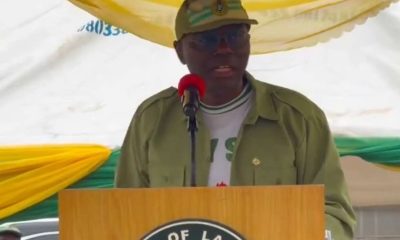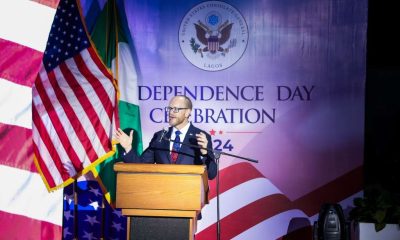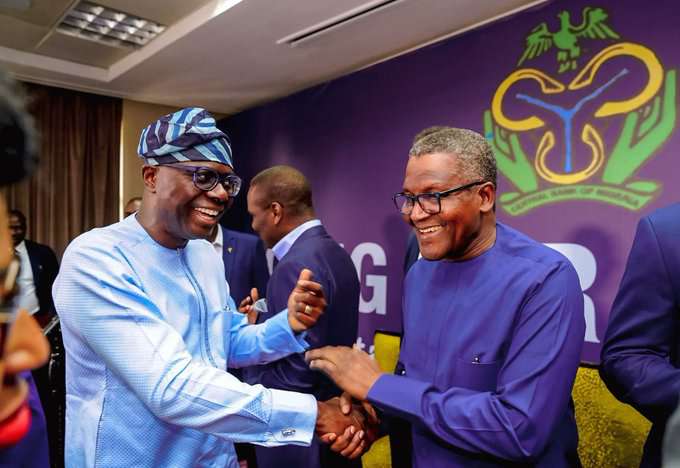Business
Accountability issues continue to dog Lagos Light rail

…as Blue, Red Lines finally roll into life
More than four decades after the ambitious Lagos Light Rail project was conceived, its Blue and Red Lines have finally rolled into life to the delight of many Lagosians.
History was made on September 4, 2023, when the state governor, Babajide Sanwo-Olu, officially opened the Blue Rail transit, which started from Mile 2 to Marina for public use after it was officially commissioned by former President Muhammadu Buhari on January 24, 2023.
On 29 February 2024, President Bola Tinubu inaugurated the second phase of the extensive rail project, the Red Line, which criss-cross between Agbado in Ogun State and Oyingbo in Lagos State.
The project brushed asides many obstacles and controversies on its path, including acute paucity of funds and accountability issues that trailed the discrepancies in its funding costs.
Originally conceived in 1983 by the administration of the first civilian governor of the state, late Alhaji Lateef Jakande, with a target delivery date of 1986, the light rail project was scrapped by the military government of former Head of State, Muhammadu Buhari in 1985, resulting in a loss of $78 million to Lagos taxpayers.
Renewed hope for the project came with the restoration of democratic rule in 1999. In 2003, the then state governor and now incumbent President of Nigeria, Bola Ahmed Tinubu, revived the rail project with an initial cost $135 million.
Construction works on the rail project, which has five lines, namely the Blue, Red, Purple, Green, Yellow and Orange lines, began in 2008 and focusing on the Blue and the Red Lines that began operations in September 2023 and February 2024 respectively.
Designs for the proposed Purple, Yellow and Orange lines are in the pipeline.
However, despite the euphoria and fanfare that greeted the construction and commencement of operations of the two rail lines, accountability issues have continued to trail the secrecy and discrepancies in their funding costs.
Many Nigerians, who spoke on the issue at the weekend, despite commending the state government for the successful completion of the first two lines out of the proposed five, raised eyebrow over their huge cost.
According to them, the almost graveyard silence on the true and actual costs of the projects, as well as the contrasting figures on the actual amount given to the public by the Chinese contractor and government officials is a cause for concern.
According to Business Hallmark’s findings, the initial estimates pegged the cost at $135 million under the Greater Lagos Urban Transportation Project, managed by the Lagos Metropolitan Area Transport Authority (LAMATA). It was later raised to approximately $1.2billion.
However, Governor Babajide Sanwo-Olu had in 2022 revealed that both the Blue and Red Lines combined would exceed N100 billion.
Controversy over the real cost of the projects first erupted in January 2019 when the contractor, China Civil Engineering Construction Company (CCECC), a subsidiary of China Railway Construction Corporation (CRCC), published on its website that it is building the Lagos Blue Line project alone at the cost of $182million.
The revelation raised huge dusts as state government officials had at different occasions put the cost of the same project at $1.2 billion (excluding the Red Line).
One of the groups that demanded answer, BudgIT, while charging the state government to clarify the monorail budget controversy, demanded for the openness of state budget.
“Just as taxpayers, BudgIT is seriously concerned about the discrepancy between the figure contained in the 2010 report delivered by China Railway Construction Corporation to its shareholders (USD$182m), as published on the company’s website, and the officially acclaimed figure by the Lagos State government, which puts the project cost at USD$1.2billion.
“The value of the Group’s new overseas contracts during the reporting period was RMB9.5568 billion, which involved the following significant overseas projects: light rail project in Lagos, Nigeria (the value of the contracts for blue line and red line was RMB1.256 billion).
“While being conscious of possible underlying factors that could be responsible for this humongous difference, we say with certitude that ambiguities of this like would have ceased to occur had the state government yielded to our demand and that of the people to put an end to its budget secrecy.
“Lagosians deserve to know, steadily and accordingly, full details of how state resources are being used without any hesitation on the part of the government.
“To put to rest all doubts and concerns, BudgIT demands that the Lagos state government should break the silence and come out clean on this matter.
“What is the overall cost of the Monorail project? Why the discrepancy between the official figure and the contractor’s report? These are key questions that demand an immediate response from the state authority”, the body had demanded.
Reacting to the queries, the Lagos State government said the unnecessary controversy was caused by the outrageous claim by some critics, who had relied on an alleged document issued by CRCC, the parent company of CCECC.
The Assistant Director, Corporate Communication, Lagos Metropolitan Area Transport Authority (LAMATA), Kolawole Ojelabi, who spoke for the state government, clarified that the $182 million figure been bandied around as the real cost of the rail project were for three contracts, namely the survey and design of the Blue and Red Rail lines for implementation respectively in 2009 and Blue Line phase 2A for the construction of earthwork, ballast, sleepers and tracks for just one kilometre and Iganmu Station between Iganmu to Mile 2 at the cost of $182 million.
“The Blue Line Rail project was awarded through an international competitive bidding and won by China Civil Engineering Construction Company (CCECC), subsidiary of China Railway Construction Corporation (CRCC).
“However, the project has been through ups and down in its implementation. As a result, and of late, a lot of untruths had been peddled about the project. It is, therefore, germane to set the record straight.
“The Blue Rail line is said to have been awarded at the contract sum of $182 million as against $1.2 billion advertised by the state government as the cost of the project.
“Those, who made the outrageous claim allegedly relied on a document attributed to CRCC, the parent company of CCECC.
“The report also alluded to the fact that the contract of RMB1.256 billion ($182 million) was for both blue and red-light rail projects.
“Instructively, the Lagos state government had awarded three contracts for the survey and design of the Blue and Red Rail lines for implementation respectively in 2009 and Blue Line phase 2A for the construction of earthwork, ballast, sleepers and tracks for one kilometre and Iganmu Station between Iganmu to Mile 2 at the cost of $182 million.
“This was captured in the CRCC’s report in 2010 and is now being falsely assumed as the cost of implementing the two rail lines.
“The Lagos State government had intended to implement the red line as the first rail line but due to the unavailability of the corridor as a result of the constraints contained in the railway Act for using the corridor, it decided to concentrate efforts on the blue line. The survey and design for the red line was, therefore, stepped down.
“The project’s global cost of about $1.17 billion as contained in the Lagos state government document on the rail project is the verified project cost of the blue line rail project as at the time it was approved in 2009.
“The project includes construction of the civil works, particularly, fixed infrastructure; rolling stocks, signalling and telecommunication, operational control centre (OCC), fare collection system, maintenance depot and equipment, power generation and supply, fencing and security of entire alignment which are currently on-going.
“The government has continued to implement the rail project within the global contract cost.
“On the comparison of the blue rail line with the Addis Ababa light rail project, it must be stated that rail construction worldwide is not compared on the basis of like-for-like because of difference in terrain (swamp, lagoon, removal of ship wreckage), design of project (elevated sections and stations), infrastructure, technology (UIC60 tracks manufactured to European standard), compensation as construction passes through already built up environment, third party issues and taxation among others.
“The project is an urban rail project and this means that a lot of issues ranging from acquisition, payment of compensation and resettlement of project affected persons would have to be taken care of to ensure a smooth sail.
“For instance, about a third of the 27-kilometre blue line rail project is elevated, crossing swampy terrain and the Lagos lagoon, where a lot of relocation, reconstruction and resettlements were involved.
“Construction within the swampy terrain and the lagoon entails that some piers foundation would go down between 40 and 88 metres”, the LAMATA spokesperson had explained.
However, the state government has continued to ignore the calls for openness, rather preferring to dish out figures expended on selected phases of the project.
For instance, the state governor, Babajide Sanwo-Olu, had in January 2022, said during an interview that the Blue Rail Line had reached about 94% stage and that over N100 billion will be needed to finance the rolling stock.
Some financial and developmental experts, however, queried the untidiness in the way the state government had handled information on the project’s budget.
“Yes, they have come out to clarify that the project was awarded at the cost of $1.17 billion at inception, that is more than 10 years ago.
“But what they have failed to give us is the breakdown of how the funds were utilised.
“Another pertinent question the government is failing to answer is how much has gone into cost variations during the course of building the project.
“Are they going to tell us that the cost of building the project, which was put at $1.17 billion more that 20 years ago is still the same, given the economic reality in the country now.
‘I can tell you that if the budget for the project was put at $1.17 billion in 2010, it would have doubled, if not tripled by now.
“So, if the cost has risen to around $3billion going by today’s realities, why are they not informing the taxpayers?
“Who prepares and approves the cost variations and why are they keeping silent on it?”, a development economist, Dr. Peju Ibiyemi demanded.
In his own comment, Architect Biodun Falegan, a builder and quantity surveyor, queried the $1.17 billion budgeted for the project in 2010, insisting that it is no longer realistic.
“The Lagos State government has not been forthcoming on whether it has reviewed the project cost upward or downwards.
“That leaves us with no other option than to adopt the officially given figure of $1.17 billion when doing our analysis.
“But we all know the truth. The arrived figure, based on the old estimate, will be far off from the actual figures.
“For instance, a 50kg bag of cement sold for between N1,300 and N1,400 in 2010. Today, it is between N9,700 and N10,500.
“So, the question is: ‘what is the actual cost of the rail project now since the $1.17 billion initial budget no longer suffice”, Falegan demanded










